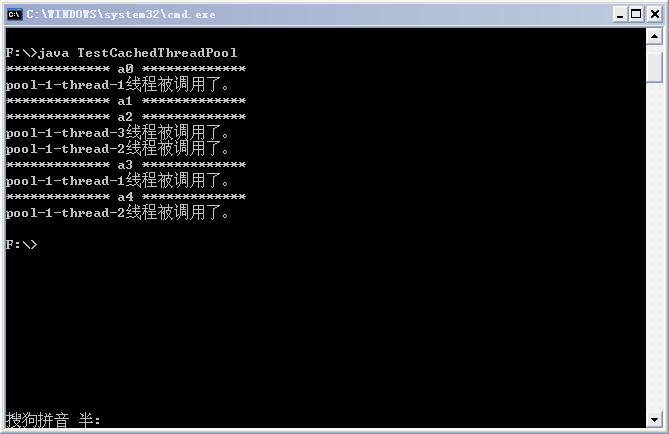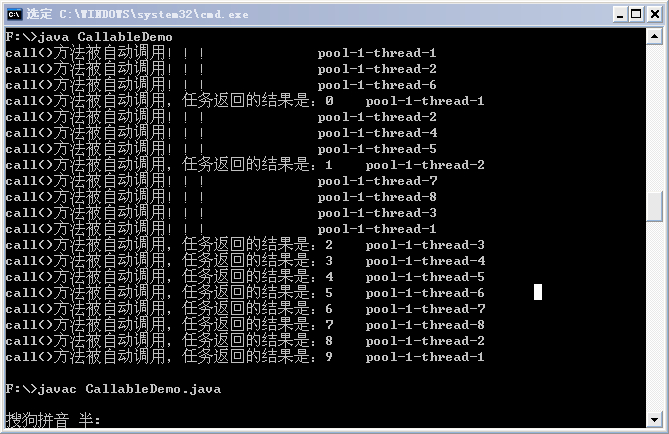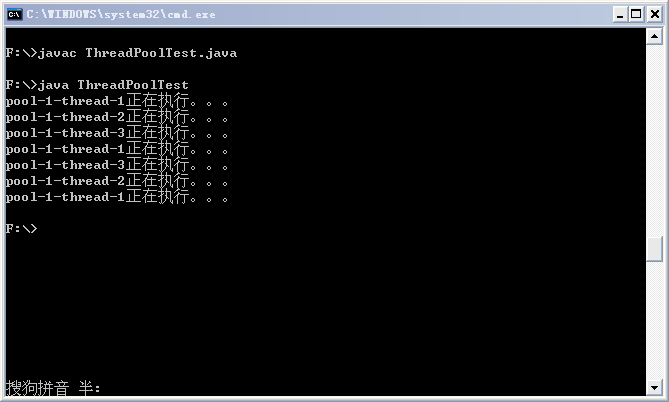创建线程的几种方式
编写多线程程序是为了实现多任务的并发执行,从而能够更好地与用户交互。一般有四种方法,Thread,Runnable,Callable, 使用 Executor 框架来创建线程池。
Runnable 和 Callable 的区别是,
(1)Callable 规定的方法是 call(),Runnable 规定的方法是 run().
(2)Callable 的任务执行后可返回值,而 Runnable 的任务是不能返回值得
(3)call 方法可以抛出异常,run 方法不可以
(4) 运行 Callable 任务可以拿到一个 Future 对象,表示异步计算的结果。它提供了检查计算是否完成的方法,以等待计算的完成,并检索计算的结果。通过 Future 对象可以了解任务执行情况,可取消任务的执行,还可获取执行结果。
1. 通过实现 Runnable 接口来创建 Thread 线程:
步骤 1:创建实现 Runnable 接口的类:
class SomeRunnable implements Runnable
{
public void run()
{
//do something here
}
}
步骤 2:创建一个类对象:
Runnable oneRunnable = new SomeRunnable();
步骤 3:由 Runnable 创建一个 Thread 对象:
Thread oneThread = new Thread(oneRunnable);
步骤 4:启动线程:
oneThread.start();
至此,一个线程就创建完成了。
注释:线程的执行流程很简单,当执行代码 oneThread.start(); 时,就会执行 oneRunnable 对象中的 void run(); 方法,
该方法执行完成后,线程就消亡了。
2. 通过实现 Callable 接口来创建 Thread 线程:
其中,Callable 接口(也只有一个方法)定义如下:
public interface Callable<V>
{
V call() throws Exception;
}
步骤 1:创建实现 Callable 接口的类 SomeCallable(略);
步骤 2:创建一个类对象:
Callable<Integer> oneCallable = new SomeCallable<Integer>();
步骤 3:由 Callable 创建一个 FutureTask 对象:
FutureTask<Integer> oneTask = new FutureTask<Integer>(oneCallable);
注释:FutureTask 是一个包装器,它通过接受 Callable 来创建,它同时实现了 Future 和 Runnable 接口。
步骤 4:由 FutureTask 创建一个 Thread 对象:
Thread oneThread = new Thread(oneTask);
步骤 5:启动线程:
oneThread.start();
至此,一个线程就创建完成了。
3. 通过继承 Thread 类来创建一个线程:
步骤 1:定义一个继承 Thread 类的子类:
class SomeThead extends Thraad
{
public void run()
{
//do something here
}
}
步骤 2:构造子类的一个对象:
SomeThread oneThread = new SomeThread();
步骤 3:启动线程:
oneThread.start();
至此,一个线程就创建完成了。
注释:这种创建线程的方法不够好,主要是因为其涉及运行机制问题,影响程序性能。
4、使用 Executor 框架来创建线程池
在 Java
5 之后,并发编程引入了一堆新的启动、调度和管理线程的 API。Executor 框架便是 Java
5 中引入的,其内部使用了线程池机制,它在 java.util.cocurrent
包下,通过该框架来控制线程的启动、执行和关闭,可以简化并发编程的操作。因此,在 Java
5 之后,通过 Executor 来启动线程比使用 Thread 的 start 方法更好,除了更易管理,效率更好(用线程池实现,节约开销)外,还有关键的一点:有助于避免 this 逃逸问题——如果我们在构造器中启动一个线程,因为另一个任务可能会在构造器结束之前开始执行,此时可能会访问到初始化了一半的对象用 Executor 在构造器中。
Executor 框架包括:线程池,Executor,Executors,ExecutorService,CompletionService,Future,Callable 等。
Executor 接口中之定义了一个方法 execute(Runnable
command),该方法接收一个 Runable 实例,它用来执行一个任务,任务即一个实现了 Runnable 接口的类。ExecutorService 接口继承自 Executor 接口,它提供了更丰富的实现多线程的方法,比如,ExecutorService 提供了关闭自己的方法,以及可为跟踪一个或多个异步任务执行状况而生成 Future 的方法。 可以调用 ExecutorService 的 shutdown()方法来平滑地关闭 ExecutorService,调用该方法后,将导致 ExecutorService 停止接受任何新的任务且等待已经提交的任务执行完成 (已经提交的任务会分两类:一类是已经在执行的,另一类是还没有开始执行的),当所有已经提交的任务执行完毕后将会关闭 ExecutorService。因此我们一般用该接口来实现和管理多线程。
ExecutorService 的生命周期包括三种状态:运行、关闭、终止。创建后便进入运行状态,当调用了 shutdown()方法时,便进入关闭状态,此时意味着 ExecutorService 不再接受新的任务,但它还在执行已经提交了的任务,当素有已经提交了的任务执行完后,便到达终止状态。如果不调用 shutdown()方法,ExecutorService 会一直处在运行状态,不断接收新的任务,执行新的任务,服务器端一般不需要关闭它,保持一直运行即可。
Executors 提供了一系列工厂方法用于创先线程池,返回的线程池都实现了 ExecutorService 接口。
public static ExecutorService newFixedThreadPool(int nThreads)
创建固定数目线程的线程池。
public static ExecutorService newCachedThreadPool()
创建一个可缓存的线程池,调用 execute 将重用以前构造的线程(如果线程可用)。如果现有线程没有可用的,则创建一个新线 程并添加到池中。终止并从缓存中移除那些已有 60 秒钟未被使用的线程。
public static ExecutorService newSingleThreadExecutor()
创建一个单线程化的 Executor。
public static ScheduledExecutorService newScheduledThreadPool(int corePoolSize)
创建一个支持定时及周期性的任务执行的线程池,多数情况下可用来替代 Timer 类。
这四种方法都是用的 Executors 中的 ThreadFactory 建立的线程,下面就以上四个方法做个比较
| 表头 | 条目一 |
|---|---|
| newCachedThreadPool() | 缓存型池子,先查看池中有没有以前建立的线程,如果有,就 reuse. 如果没有,就建一个新的线程加入池中缓存型池子通常用于执行一些生存期很短的异步型任务因此在一些面向连接的 daemon 型 SERVER 中用得不多。但对于生存期短的异步任务,它是 Executor 的首选。能 reuse 的线程,必须是 timeout IDLE 内的池中线程,缺省 timeout 是 60s, 超过这个 IDLE 时长,线程实例将被终止及移出池。注意,放入 CachedThreadPool 的线程不必担心其结束,超过 TIMEOUT 不活动,其会自动被终止。 |
| newFixedThreadPool(int) | newFixedThreadPool 与 cacheThreadPool 差不多,也是能 reuse 就用,但不能随时建新的线程其独特之处: 任意时间点,最多只能有固定数目的活动线程存在,此时如果有新的线程要建立,只能放在另外的队列中等待,直到当前的线程中某个线程终止直接被移出池子和 cacheThreadPool 不同,FixedThreadPool 没有 IDLE 机制(可能也有,但既然文档没提,肯定非常长,类似依赖上层的 TCP 或 UDP IDLE 机制之类的),所以 FixedThreadPool 多数针对一些很稳定很固定的正规并发线程,多用于服务器从方法的源代码看,cache 池和 fixed 池调用的是同一个底层 池,只不过参数不同:fixed 池线程数固定,并且是 0 秒 IDLE(无 IDLE) cache 池线程数支持 0-Integer.MAX_VALUE( 显然完全没考虑主机的资源承受能力),60 秒 IDLE |
| newScheduledThreadPool(int) | 调度型线程池这个池子里的线程可以按 schedule 依次 delay 执行,或周期执行 |
| SingleThreadExecutor() | 单例线程,任意时间池中只能有一个线程用的是和 cache 池和 fixed 池相同的底层池,但线程数目是 1-1,0 秒 IDLE(无 IDLE) |
一般来说,CachedTheadPool 在程序执行过程中通常会创建与所需数量相同的线程,然后在它回收旧线程时停止创建新线程,因此它是合理的 Executor 的首选,只有当这种方式会引发问题时(比如需要大量长时间面向连接的线程时),才需要考虑用 FixedThreadPool。(该段话摘自《Thinking in Java》第四版)
Executor 执行 Runnable 任务
通过 Executors 的以上四个静态工厂方法获得 ExecutorService 实例,而后调用该实例的 execute(Runnable command)方法即可。一旦 Runnable 任务传递到 execute()方法,该方法便会自动在一个线程上
[java] view pl
import java.util.concurrent.ExecutorService;
import java.util.concurrent.Executors;
public class TestCachedThreadPool{
public static void main(String[] args){
ExecutorService executorService = Executors.newCachedThreadPool();
// ExecutorService executorService = Executors.newFixedThreadPool(5);
// ExecutorService executorService = Executors.newSingleThreadExecutor();
for (int i = 0; i < 5; i++){
executorService.execute(new TestRunnable());
System.out.println("************* a" + i + " *************");
}
executorService.shutdown();
}
}
class TestRunnable implements Runnable{
public void run(){
System.out.println(Thread.currentThread().getName() + "线程被调用了。");
}
}
某次执行后的结果如下:
从结果中可以看出,pool-1-thread-1 和 pool-1-thread-2 均被调用了两次,这是随机的,execute 会首先在线程池中选择一个已有空闲线程来执行任务,如果线程池中没有空闲线程,它便会创建一个新的线程来执行任务。
Executor 执行 Callable 任务
在 Java 5 之后,任务分两类:一类是实现了 Runnable 接口的类,一类是实现了 Callable 接口的类。两者都可以被 ExecutorService 执行,但是 Runnable 任务没有返回值,而 Callable 任务有返回值。并且 Callable 的 call()方法只能通过 ExecutorService 的 submit(Callable task) 方法来执行,并且返回一个 Future,是表示任务等待完成的 Future。
Callable 接口类似于 Runnable,两者都是为那些其实例可能被另一个线程执行的类设计的。但是 Runnable 不会返回结果,并且无法抛出经过检查的异常而 Callable 又返回结果,而且当获取返回结果时可能会抛出异常。Callable 中的 call()方法类似 Runnable 的 run() 方法,区别同样是有返回值,后者没有。
当将一个 Callable 的对象传递给 ExecutorService 的 submit 方法,则该 call 方法自动在一个线程上执行,并且会返回执行结果 Future 对象。同样,将 Runnable 的对象传递给 ExecutorService 的 submit 方法,则该 run 方法自动在一个线程上执行,并且会返回执行结果 Future 对象,但是在该 Future 对象上调用 get 方法,将返回 null。
下面给出一个 Executor 执行 Callable 任务的示例代码:
import java.util.ArrayList;
import java.util.List;
import java.util.concurrent.*;
public class CallableDemo{
public static void main(String[] args){
ExecutorService executorService = Executors.newCachedThreadPool();
List<Future<String>> resultList = new ArrayList<Future<String>>();
//创建10个任务并执行
for (int i = 0; i < 10; i++){
//使用ExecutorService执行Callable类型的任务,并将结果保存在future变量中
Future<String> future = executorService.submit(new TaskWithResult(i));
//将任务执行结果存储到List中
resultList.add(future);
}
//遍历任务的结果
for (Future<String> fs : resultList){
try{
while(!fs.isDone);//Future返回如果没有完成,则一直循环等待,直到Future返回完成
System.out.println(fs.get()); //打印各个线程(任务)执行的结果
}catch(InterruptedException e){
e.printStackTrace();
}catch(ExecutionException e){
e.printStackTrace();
}finally{
//启动一次顺序关闭,执行以前提交的任务,但不接受新任务
executorService.shutdown();
}
}
}
}
class TaskWithResult implements Callable<String>{
private int id;
public TaskWithResult(int id){
this.id = id;
}
/**
* 任务的具体过程,一旦任务传给ExecutorService的submit方法,
* 则该方法自动在一个线程上执行
*/
public String call() throws Exception {
System.out.println("call()方法被自动调用!!! " + Thread.currentThread().getName());
//该返回结果将被Future的get方法得到
return "call()方法被自动调用,任务返回的结果是:" + id + " " + Thread.currentThread().getName();
}
}
某次执行结果如下:

从结果中可以同样可以看出,submit 也是首先选择空闲线程来执行任务,如果没有,才会创建新的线程来执行任务。另外,需要注意:如果 Future 的返回尚未完成,则 get()方法会阻塞等待,直到 Future 完成返回,可以通过调用 isDone()方法判断 Future 是否完成了返回。
自定义线程池
自定义线程池,可以用 ThreadPoolExecutor 类创建,它有多个构造方法来创建线程池,用该类很容易实现自定义的线程池,这里先贴上示例程序:
import java.util.concurrent.ArrayBlockingQueue;
import java.util.concurrent.BlockingQueue;
import java.util.concurrent.ThreadPoolExecutor;
import java.util.concurrent.TimeUnit;
public class ThreadPoolTest{
public static void main(String[] args){
//创建等待队列
BlockingQueue<Runnable> bqueue = new ArrayBlockingQueue<Runnable>(20);
//创建线程池,池中保存的线程数为3,允许的最大线程数为5
ThreadPoolExecutor pool = new ThreadPoolExecutor(3,5,50,TimeUnit.MILLISECONDS,bqueue);
//创建七个任务
Runnable t1 = new MyThread();
Runnable t2 = new MyThread();
Runnable t3 = new MyThread();
Runnable t4 = new MyThread();
Runnable t5 = new MyThread();
Runnable t6 = new MyThread();
Runnable t7 = new MyThread();
//每个任务会在一个线程上执行
pool.execute(t1);
pool.execute(t2);
pool.execute(t3);
pool.execute(t4);
pool.execute(t5);
pool.execute(t6);
pool.execute(t7);
//关闭线程池
pool.shutdown();
}
}
class MyThread implements Runnable{
@Override
public void run(){
System.out.println(Thread.currentThread().getName() + "正在执行。。。");
try{
Thread.sleep(100);
}catch(InterruptedException e){
e.printStackTrace();
}
}
}
运行结果如下:

从结果中可以看出,七个任务是在线程池的三个线程上执行的。这里简要说明下用到的 ThreadPoolExecuror 类的构造方法中各个参数的含义。
public ThreadPoolExecutor (int corePoolSize, int maximumPoolSize, long keepAliveTime, TimeUnit unit,BlockingQueue<Runnable> workQueue)
- corePoolSize:线程池中所保存的线程数,包括空闲线程。
- maximumPoolSize:池中允许的最大线程数。
- keepAliveTime:当线程数大于核心数时,该参数为所有的任务终止前,多余的空闲线程等待新任务的最长时间。
- unit:等待时间的单位。
- workQueue:任务执行前保存任务的队列,仅保存由 execute 方法提交的 Runnable 任务。

